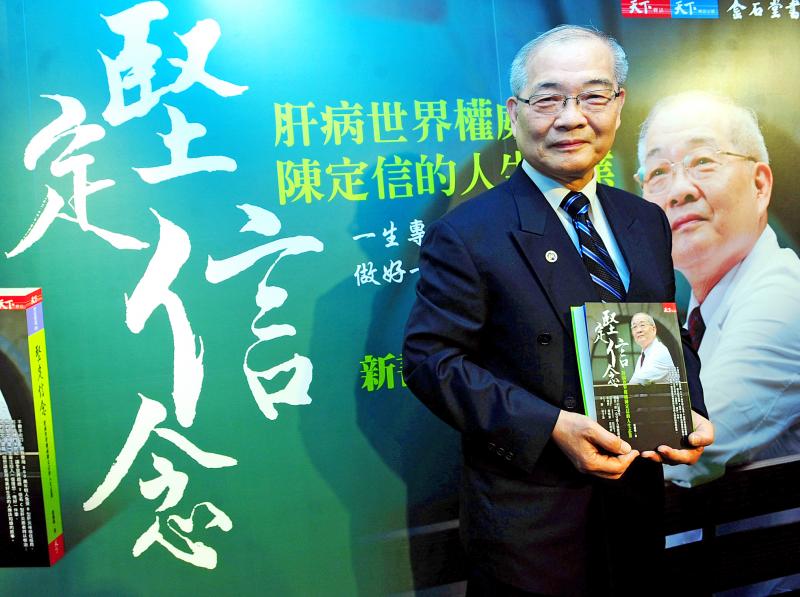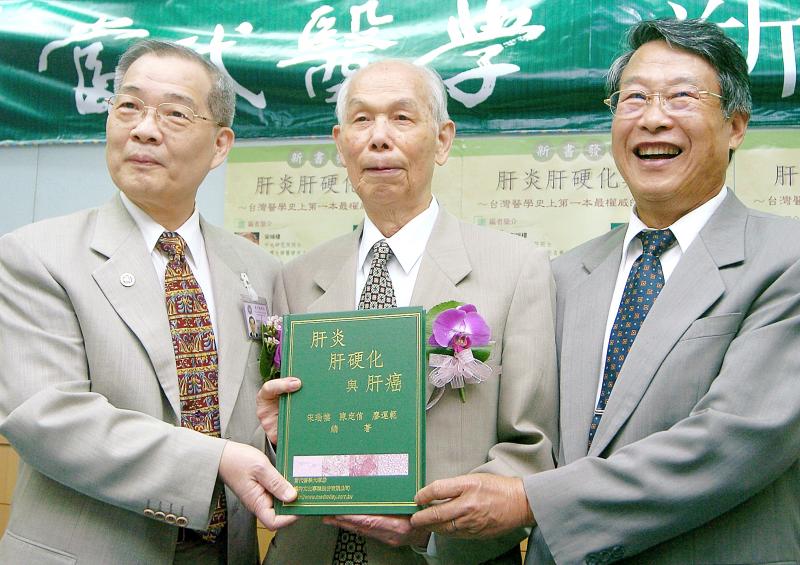Every time Chen Ding-shinn (陳定信) saw a liver cancer patient in his ward, it reminded him of his father, who died from the disease at the age of 49. Historically, Taiwanese suffered from an unusually high prevalence of liver ailments as well as cancer, and Chen was troubled by the number of terminal patients.
After decades of research, Chen and other experts found that Taiwan had the highest percentage of hepatitis B carriers in the world, which often developed into cirrhosis and cancer. In the early 1980s, he served as a key member of the Hepatitis Prevention Council (肝炎防治委員會), which helped Taiwan become the first country in the world to implement a nationwide hepatitis B vaccination program.
All newborns in Taiwan were vaccinated in 1986 — six years before the WHO recommended that all countries integrate the vaccine into their national immunization programs. According to the book Hepatitis Combat (肝炎聖戰), today over 179 countries follow the recommendation.

Photo: Wang Yi-sung, Taipei Times
Chen died on June 24 of pancreatic cancer at the age of 76. The nation mourned him as the “Liver King” (肝帝, homophonous to the Mandarin pronunciation of Gandhi) and thanked him for saving the lives of generations of Taiwanese.
NATIONAL DISEASE
Medical experts during the Japanese era already noticed an unusually high occurrence of liver ailments among Taiwanese. But they never found the cause.

Photo: CNA
Chen was born in 1943 in today’s Yingge District (鶯歌), New Taipei City. During his fourth year at National Taiwan University’s College of Medicine, his father was diagnosed with liver cancer, which was considered Taiwan’s “national disease” and leading cause of death at the time.
Today, it has been proven that the most common risk for liver cancer is chronic infection of hepatitis B or C, but that connection had yet to be made. In the 1950s, most experts believed that liver disease was caused by parasites and poor diet. But little changed as Taiwan’s standard of living improved in the 1960s.
“Most people had enough to eat by then, and other infectious diseases had subsided. But why was liver disease still on the rise?” hepatitis research pioneer Lo Kuang-jui (羅光瑞) recalls in Hepatitis Combat.

Photo: Liu Hsin-de, Taipei Times
“I’ve already started studying to be a doctor, why couldn’t I still save my father?” Chen lamented in a biography about his life, Unwavering Conviction (堅定信念), by Goya Lan (藍麗娟). During his clinical clerkship, he saw countless terminal liver cancer patients, many of them men in their 40s and 50s. He thought about the families like his that were traumatized by liver cancer, and vowed to find a solution.
Chen became a star pupil of National Taiwan University (NTU) College of Medicine professor Sung Juei-low (宋瑞樓), who in 1954 became the first physician in Taiwan to conduct a liver biopsy using a needle, demonstrating the existence of the hepatitis virus.
Sung is also known for conducting the very first endoscopy in Taiwan among other pioneering achievements. While Chen is the “Liver King,” Sung is remembered as the “Father of liver disease research.”

Photo: Lin Hsin-han, Taipei Times
Though Chen could have opened his own practice, he opted to stay at NTU after completing medical school to continue his research on liver cancer.
“I’ve never seen such a busy, tired, yet poor doctor,” he recalls relatives saying.
Chen and Sung would work closely together over the years as one of three teams in Taiwan focusing on liver disease. The other two were headed by Lo and the US Naval Medical Research Unit Two. Not only did they prove that Taiwan had the highest percentage of hepatitis B carriers in the world, they also found evidence directly linking hepatitis to liver cancer. Now Chen understood why so many people suffered from the disease.

Photo courtesy of Erskine Palmer via Pixnio
Centers of Disease Control (CDC) statistics from the 1980s show that prior to the vaccination program, 90 percent of the population had been infected with hepatitis B at some point before they turned 40, with 18 to 20 percent being carriers. By comparison, the US only had 1 percent. While the virus has historically been more prevalent in Asia than in the West, experts are still unsure why the numbers in Taiwan were this high.
NATIONAL VACCINE
After finding that mothers who were hepatitis B carriers had a 70 percent chance of passing on the virus to the child, Chen and Sung were firmly convinced that the most effective way to combat the virus was to vaccinate newborns as soon as possible. Starting in 1978, the two tirelessly persuaded the government to take measures to curb the virus.

Photo courtesy of Chung Hwa Rotary Foundation
Meanwhile, American physician and epidemiologist R Palmer Beasley arrived in Taiwan in 1972 to conduct research on hepatitis B as part of the US Navy medical team. In 1980, he proposed to test the vaccine on children in the Taipei area. They chose Taiwanese instead of American babies due to the nation’s much higher prevalence of carriers.
However, this caused a stir in society and led to headlines like: “Are the Americans using Taiwanese children as guinea pigs?” Others accused the proponents of pushing this program to further their medical career.
Academics were also divided on the issue.
Things only got going when Beasley convinced then-premier Sun Yun-suan (孫運璿) to support the project.
“This project is too important to Taiwan,” Sun reportedly said after Beasley’s 30-minute presentation. “We have to do this.”
Public resistance remained, especially over the safety of the vaccine in light of the AIDS epidemic. In 1981, the Department of Health (today’s Ministry of Health and Welfare) finally gave the green light.
The test results were encouraging, Sung recalls in Hepatitis Combat, and the government managed to convince the skeptical public of the importance of vaccination.
The Department of Health in 1982 launched the Hepatitis Prevention Council (肝炎防治委員會), which included Sung and Chen. Chen’s wife Hsu Hsu-mei (許須美), who worked for the Centers of Disease Control, was in charge of implementing the vaccination program.
Sung, Lo, Chen and other experts traveled the nation extensively to explain the importance of the vaccine to opposing experts, politicians, medical staff and the public. They frequently appeared on radio and television, and personally inspected any promotional material from the CDC. Chen says he got used to being yelled at during this time.
In July 1984, all newborns whose mothers were carriers received the vaccine, which was administered four times over one year. This was expanded to all newborns in 1986, and later children, relatives of carriers and medical personnel.
It worked. Twenty years later, the hepatitis rate in children covered by the program dropped by 85 percent. However, since there are still about 3 million existing carriers that were infected before the program launched, the disease remains a serious health issue.
Taiwan in Time, a column about Taiwan’s history that is published every Sunday, spotlights important or interesting events around the nation that either have anniversaries this week or are tied to current events.

This is the year that the demographic crisis will begin to impact people’s lives. This will create pressures on treatment and hiring of foreigners. Regardless of whatever technological breakthroughs happen, the real value will come from digesting and productively applying existing technologies in new and creative ways. INTRODUCING BASIC SERVICES BREAKDOWNS At some point soon, we will begin to witness a breakdown in basic services. Initially, it will be limited and sporadic, but the frequency and newsworthiness of the incidents will only continue to accelerate dramatically in the coming years. Here in central Taiwan, many basic services are severely understaffed, and

Jan. 5 to Jan. 11 Of the more than 3,000km of sugar railway that once criss-crossed central and southern Taiwan, just 16.1km remain in operation today. By the time Dafydd Fell began photographing the network in earnest in 1994, it was already well past its heyday. The system had been significantly cut back, leaving behind abandoned stations, rusting rolling stock and crumbling facilities. This reduction continued during the five years of his documentation, adding urgency to his task. As passenger services had already ceased by then, Fell had to wait for the sugarcane harvest season each year, which typically ran from

It is a soulful folk song, filled with feeling and history: A love-stricken young man tells God about his hopes and dreams of happiness. Generations of Uighurs, the Turkic ethnic minority in China’s Xinjiang region, have played it at parties and weddings. But today, if they download it, play it or share it online, they risk ending up in prison. Besh pede, a popular Uighur folk ballad, is among dozens of Uighur-language songs that have been deemed “problematic” by Xinjiang authorities, according to a recording of a meeting held by police and other local officials in the historic city of Kashgar in

It’s a good thing that 2025 is over. Yes, I fully expect we will look back on the year with nostalgia, once we have experienced this year and 2027. Traditionally at New Years much discourse is devoted to discussing what happened the previous year. Let’s have a look at what didn’t happen. Many bad things did not happen. The People’s Republic of China (PRC) did not attack Taiwan. We didn’t have a massive, destructive earthquake or drought. We didn’t have a major human pandemic. No widespread unemployment or other destructive social events. Nothing serious was done about Taiwan’s swelling birth rate catastrophe.